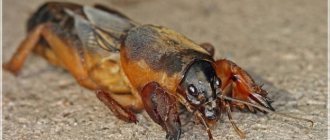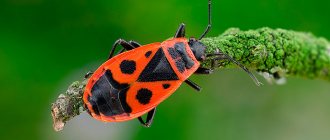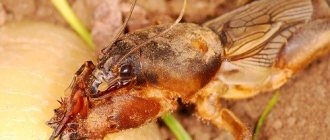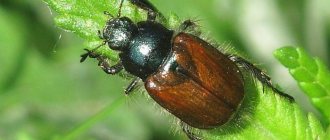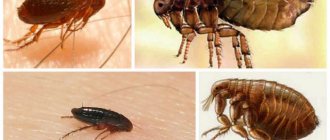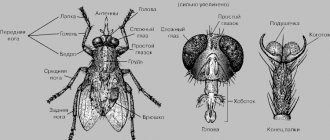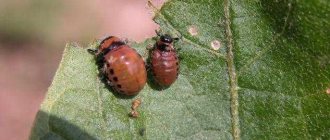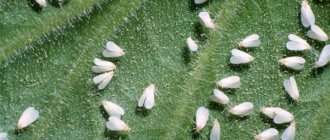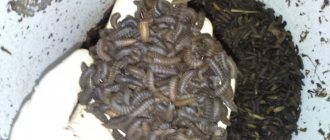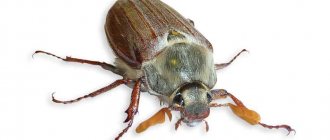Mole cricket or, as it is also called, cabbage weed, is quite widespread in our country. This is a soil pest that prefers to feast on tubers, bulbs and rhizomes of cultivated plants, as well as their seeds, which causes quite serious damage to agricultural land. Most often, mole cricket larvae are found in gardens, where the soil is always well cultivated and fertilized - it is in such soil that it is quite easy for the insect to make its tunnels. But in gardens where there is a lot of turf, this pest, as a rule, does not live, and if it does, it does not last long, trying to fly to the “cozy” garden as quickly as possible.
Appearance
You can see what a mole cricket and its larva look like in our article. This unique creature is unlike any other insect. You can see a photo of the kapustyanka below and get information about who the mole cricket is.
The common mole cricket reaches 7 cm, excluding the mustache and tail. With them, the length of an adult insect is 12 cm. The photo of the garden mole cricket looks terrifying and gives rise to various legends - the insect bites, the poison is deadly, etc.
Kapustyanka Photo and description of the mole cricket:
- Large insects with a cylindrical body shape and folded wings on the back reach a size of 12 cm, but the average body length is about 5 cm.
- Small but bulging eyes, like those of a crayfish, are clearly visible on the head.
- The forelimbs are spade-shaped and equipped with several claws. Strong, massive, designed for digging soil.
- The second pair of limbs are long, thin, and mobile. Helps the insect crawl quickly on the surface of the earth.
- The hind limbs are somewhat longer than the rest and springy. Allows you to jump well.
- The abdomen and head are protected by a dense shell. The abdominal cavity is 2 times larger than the thoracic cavity. The photo of the mole cricket demonstrates this well.
- On the head there are long mustaches and a pair of tentacles. The back of the body ends with long whiskers.
- Two pairs of wings are pressed tightly to the back. The first wings are oval-shaped and short. The second ones are long and narrow. Thanks to them, the mole cricket beetle can fly and rise 5 m high from the ground. The process of how a large insect flies can be described in one word - noisy. Only an adult bear is endowed with such capabilities.
The appearance of individual species may vary slightly. Due to underdeveloped or missing wings, the insect loses the ability to fly. Below is the mole cricket insect in the photo. Different species of this insect are distributed throughout the world. Habitat: fertile soil.
Medvedka
May beetle and mole cricket: comparison of larvae
First of all, we should return to the features of the mole cricket’s metamorphosis. As mentioned above, it is an insect with incomplete transformation, that is, young animals emerge from the egg, which in appearance resemble sexually mature individuals. Therefore, the mole cricket larva cannot look like a caterpillar - it looks like a smaller copy of the imago.
And if we talk about the larva of the cockchafer, then it will already be similar to a caterpillar. A more detailed description of it is as follows:
- the body is painted white, about 2 cm long and no more than 0.8 cm thick;
- on the front of the body there are three pairs of legs;
- there are small hairs on the body and legs;
- dark brown dots are clearly visible on the sides;
- the back of the body is darker.
As you can see, recognizing the pest is quite simple. And knowing who exactly settled on the site, you can quickly get rid of the uninvited guest. But remember that the fight against mole crickets should begin immediately - as soon as eggs or several adult insects are discovered. If you do this, the parasites can cause quite serious harm. They attack any grain and fodder crops, as well as vegetables, young plants and seedlings of fruit, berry and ornamental crops. At the same time, the mole cricket settles both in open ground and in greenhouses. It mainly gnaws out grains and underground parts of plants, but sometimes it can also eat seedlings. As a result of its activity, plants weaken and die over time. But the loss can also be direct; this happens when insects damage potato and sugar beet tubers.
Don’t waste time and start destroying the mole cricket immediately. Have a good harvest!
Stages of development
The insect goes through several stages - egg, larva, nymph, adult. The mating season, reproduction begins in May, lasts throughout the warm period. How the mole cricket reproduces looks beautiful and melodious.
The male has the ability to sing and makes real trills at night with different modulations and chirping. In this way it attracts the attention of females. Sexually mature females crawl out of their burrows, rise into the air, and fly towards their fate. Capable of traveling up to 8 km.
Stages of development of the mole cricket: after fertilization, the female begins to arrange her own home and nest. The depth of the structure depends on the characteristics of the soil. In chernozem with high humidity, the shelter is located at a depth of 5 cm. In sandy, dry soil - 15 cm. But it can reach up to 70 cm in depth.
When a mole cricket lays eggs – the common mole cricket lays eggs 2 weeks after fertilization. In one clutch there are from 25 to 60 pieces. Mole cricket eggs are about 1 mm in size. The female provides optimal conditions and takes care of the successful breeding of offspring.
Appearance of the larva
The offspring emerge from the egg after 2 weeks. The mole cricket larvae look helpless - blind, inactive, the color is close to red. The mole cricket larva in the photo is located below.
The mole cricket larva After birth, it immediately begins to feed. They eat plant foods. A few days later, the earthen mole cricket goes through its first molt and turns into a nymph, resembling an adult in appearance. Transformation into a full-fledged individual is a long, dangerous process. Only strong nymphs can cope with it. The weak risk death. Photo and description of the larva are below. Before this, it looks like a caterpillar, resembles a cockchafer larva, but has some differences.
How long does an insect live - the formation of the imago occurs slowly. It takes about 2 years for the larva to mature. During this time, the individual goes through about 10 molts, at the last stage the genitals are formed.
On a note!
An adult lives about 1.5 years. In artificially created conditions – 3 years. The entire life cycle lasts about 5 years.
Habitats
Where the pest lives - the family overwinters deep in the ground. The nest is built at a distance of 2 m from the surface. It can settle down under a pile of manure or directly in it. With the onset of heat, when the soil warms up to 12 degrees, it intensifies its activity. Traces are visible in the garden, the results of sabotage. In countries with warm climates it is active all year round.
Nest Features
Mole cricket burrows in the garden are a unique structure with numerous passages and exits. The main part looks like a rectangle. There the insect rests, hides from enemies, and breeds offspring. On the surface, the exit or entrance looks like a large or small hole. You can catch a mole cricket in various ways.
The mole cricket's passages on the ground extend from the nest in different directions. They have a spiral shape, the hole goes to the surface. In this way, the female ensures free air circulation and heat supply. To prevent the area from being shaded by plants, the female gnaws the stems, after which the crops dry out. Eggs are laid at the time when seedlings are planted in the beds, which is why many gardeners have to save them.
Mole cricket habitat
On a note!
Numerous labyrinths are located underground at a depth of 5–70 cm. It all depends on soil moisture. If there is a lack of moisture, the larvae either do not hatch or die immediately after hatching.
Prevention
As a preventative measure, it is recommended to dig up the garden twice a year. The digging depth should be more than 20 cm. If pest nests appear, you can destroy and destroy them.
Often gardeners fertilize the soil with manure, scattering it around the garden. Along with it, mole cricket eggs may fall onto the treated area. That is why it is recommended to fertilize in the fall. In winter, larvae located on the surface of the ground will not be able to survive.
Protective beds on which garlic is planted show good results. It is also recommended to throw it into a hole with other crops. In addition, beds with chrysanthemums, marigolds, and calendula repel pests from the plot of land.
Behavior
The mole cricket spends most of its life underground. There it digs passages, builds labyrinths, and builds nests. It comes to the surface at dusk in warm weather. Looks for food or rises into the air to search for a male.
The body structure of the mole cricket allows it to swim on the surface of the water. She calmly overcomes a large puddle and escapes the flood. But if water gets into the burrow, the insect dies.
The heat-loving insect successfully survives winter frosts through half the soil. With the onset of heat it gradually rises to the surface. The presence of the pest in garden plots can be noticed as early as April. Paths form in the ground, footprints are visible, and plants die.
On a note!
The mole cricket is a timid creature that hides in a hole at the slightest rustle. It is impossible to catch her with your own hands. But, if you build a trap, you can significantly reduce the number of insects on the site.
How to detect an appearance in the garden
The insect, of course, is secretive, but all living things leave traces. Including in the literal sense of the word. Early in the morning, before the dew has dried, the insect can be detected by the trail of the abdomen, which it drags behind itself.
You can suspect the presence of pests by looking at young, drying plants. If it turns out that the seedling's stem has been chewed, it is almost certainly a mole cricket. Other garden pests gnaw roots or eat leaves.
Later, characteristic holes appear in the ground. The hole of a mole cricket and a mole cricket can be confused, but in a cricket it is 1 cm in diameter, and in a mole cricket it is 2-3. However, the cricket has the same food supply and does almost as much harm.
Food preferences
What the mole cricket eats is of interest to gardeners, gardeners, and lovers of flora and fauna. The mole cricket insect is a predator that prefers plant foods.
The mole cricket eats the soil's contents. It feeds on roots, roots, and the green part of plants that are located directly above the soil. Finds food in the depths of the earth - small insects, larvae, earthworms. A delicacy is the pupa of other insects, caterpillars, and butterflies.
Interesting!
Its feeding characteristics make the mole cricket both a useful and harmful creature. In the forest, the insect brings great benefits - it loosens the soil, saturates it with oxygen, and destroys pests. In the garden, in the garden, they are trying to get rid of mole crickets with all their might. In garden beds, it chews through green stems, destroys the root system, and gnaws root crops. Does not allow seedlings to take root or seeds to germinate.
How to understand that an area is infested with a mole cricket
The probability of seeing a mole cricket during the day is negligible, which creates some difficulties in determining whether an area is infested with this pest.
A combination of signs indicates the activity of an insect:
- mass death of seedlings;
- wilting of plants;
- damage to root crops;
- the appearance of small loose piles of earth;
- earthen paths visible on moist soil;
- holes in the ground (entrance to the burrow).
Larvae and adult mole crickets harm crops, damaging their root system. They feed on the roots of plants: tomatoes, potatoes, carrots, cabbage, eggplants, peppers, ornamental flowers, and cereals. Adult insects are more omnivorous than larvae. A developed individual readily eats worms, small insects and large beetle larvae.
Advice. Clean the area thoroughly in the fall after harvesting. With the beginning of spring, when the top layer of the earth warms up to 10-15 degrees, mole crickets emerge from their winter holes and begin to feed on the remaining fruits.
An adult mole cricket feeds on plant roots and can damage up to 15 plants per night
Natural enemies
The mole cricket lives everywhere, is food for many animals, is susceptible to fungal diseases, and acts as an intermediate link in the reproduction of other insects.
Who eats mole cricket:
- birds;
- toads;
- lizards;
- moles;
- cats;
- any rodent;
- insectivorous mammals;
- spiders.
Fungal diseases can reduce the number of insects. The ticks are annoying and exhausting. Wasps use the insect to breed their own offspring - they lay eggs in the body of the mole cricket. The larvae hatch, suck the juices from the victim’s body, leading to its death.
They are grown in a terrarium for fun or as food for animals and insectivorous inhabitants. In some countries, delicious dishes are prepared from them, and traditional medicine claims that they help cope with tuberculosis.
origin of name
These insects became bearers of the title “mole crickets” for their large size, dark brown color, powerful front legs, and slightly downy body.
The second name of the individual is cabbage, attached due to its great love for the roots of young cabbage. Such a bug is also called a cricket - mole (translated from Latin), and for good reason - because the bug with its body structure fully resembles a cricket, it even creates a corresponding sound.
The name “mole” is also natural and quite logical - it is the front legs that help it easily overcome soil layers in search of the required food.
Also, a less common name is “top” - this name justifies its structure of the front legs. After all, they have sharp ends, slightly reminiscent of the sharp fangs of a wolf.
